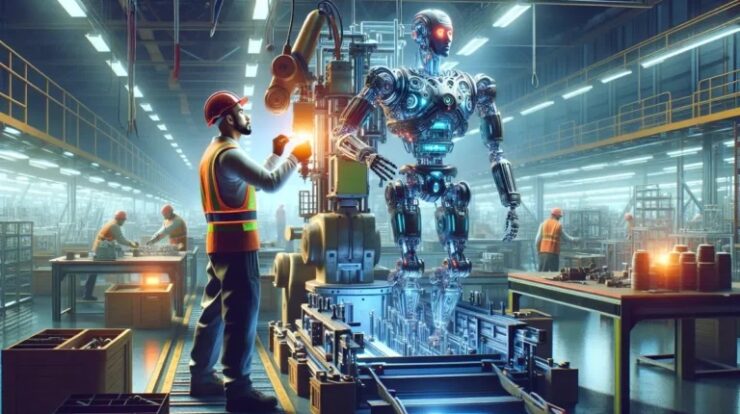
In manufacturing, automation stands at the forefront of innovation, enhancing operational efficiency, quality, and safety. Among the most transformative advancements are collaborative robots, or cobots, specifically designed to work alongside human operators. These robots are not merely tools; they are pivotal players in modern welding applications, redefining workflows and improving overall productivity.
Understanding Collaborative Robots
Collaborative robots differ significantly from traditional industrial robots, primarily in their design and operational philosophy. Cobots are engineered to work safely alongside humans, featuring advanced sensors and safety mechanisms that allow them to detect human presence and adjust their actions accordingly. This capability enables a harmonious interaction between humans and robots, making cobots particularly suitable for environments where tasks require both human intuition and robotic precision.
One of the standout features of cobots is their flexibility. Unlike their traditional counterparts, which are often fixed in place and require extensive programming for each task, cobots can be easily reconfigured to perform different welding processes. This adaptability is crucial in a manufacturing world that values agility and responsiveness to changing market demands.
The Role of Cobots in Welding Applications
Cobots are making significant inroads into various welding processes, effectively enhancing traditional techniques such as MIG (Metal Inert Gas) and TIG (Tungsten Inert Gas) welding. Their integration into welding tasks allows for improved efficiency and output quality, addressing the needs of modern manufacturing. By complementing traditional welding processes, collaborative robots are often integrated with advanced systems, including a robotic welding machine, to optimize efficiency and precision.
In practice, cobots take on roles that are repetitive or ergonomically challenging for human workers. For instance, they can manage the positioning of parts for welding, ensuring that the assembly is correctly aligned before the welding process begins. By performing these time-consuming tasks, cobots free skilled welders to focus on more intricate aspects of the job that require critical thinking and specialized skills.
Benefits of Using Collaborative Robots in Welding
The advantages of integrating collaborative robots into welding operations are manifold and impactful.
Increased Safety
One of the foremost benefits of cobots in welding is enhanced safety. The welding environment presents various hazards, from exposure to high temperatures to the risks associated with heavy lifting. Cobots significantly mitigate these risks by assuming the more dangerous aspects of welding operations. Their built-in safety features, such as emergency stop buttons and force-limiting capabilities, enable them to function alongside humans without compromising safety.
Enhanced Precision and Consistency
Precision is paramount in welding applications, where even minor discrepancies can lead to significant defects. Collaborative robots excel in delivering high levels of accuracy, ensuring that welding parameters—such as speed, angle, and temperature—are maintained consistently throughout the process. This reliability leads to fewer rework cycles and a lower incidence of defects, ultimately resulting in higher-quality products.
The consistent quality offered by cobots also allows manufacturers to adhere to stringent industry standards, which is essential for maintaining customer trust and meeting regulatory requirements.
Improved Flexibility and Adaptability
In today’s dynamic manufacturing landscape, the ability to pivot quickly in response to changing demands is critical. Cobots provide this flexibility through their easy programming and reconfiguration capabilities. If a manufacturer decides to shift production lines to accommodate new product designs or changes in market demand, cobots can be quickly adjusted to meet these new requirements.
This adaptability not only minimizes downtime but also enhances the overall efficiency of production systems. For instance, a cobot can be swiftly trained to handle different welding tasks, allowing manufacturers to maintain production flow even during transitions.
Cost-Effectiveness
While the upfront investment in collaborative robots may seem substantial, the long-term cost benefits often outweigh the initial costs. Cobots can significantly reduce labor costs by automating repetitive tasks, leading to higher overall productivity. With the ability to work continuously, they help manufacturers meet increased production demands without the need for additional labor.
Key Technologies Enabling Cobot Functionality
Several key technologies are driving the capabilities of collaborative robots in welding applications, enhancing their functionality and effectiveness.
Advanced Sensors and Safety Systems
Cobots are equipped with sophisticated sensors that allow them to navigate their environments safely. These sensors enable the robots to detect the presence of human workers and adjust their movements accordingly, preventing accidents and fostering a safe collaborative environment. The technology behind these sensors has evolved significantly, incorporating advanced algorithms that enhance the robots’ responsiveness and situational awareness.
Machine Learning and AI Capabilities
The integration of artificial intelligence and machine learning into cobot systems is revolutionizing their operational capabilities. By analyzing historical data from welding tasks, cobots can learn and optimize their techniques over time. This not only improves the quality of welds but also enhances the overall efficiency of the welding process.
AI-driven cobots can adapt to variations in welding materials and conditions, further increasing their utility across different applications. This ability to learn and improve makes them valuable assets in any manufacturing setting.
Conclusion
Collaborative robots are reshaping the landscape of automated welding, offering manufacturers enhanced safety, precision, flexibility, and cost-effectiveness. These advanced cobots, with their ability to work alongside human operators, are not only transforming traditional welding techniques but are also driving greater efficiency in modern manufacturing environments.
As technologies like AI, machine learning, and Industry 4.0 integration continue to evolve, cobots will become even more critical in optimizing welding processes and addressing the growing demands of the industry. By embracing these innovations, manufacturers can stay competitive and lead the way in the future of automation.


